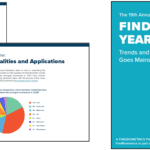As the leading identity technology industry trade group, the International Biometrics + Identity Association (IBIA) is dedicated to promoting informed education, engaging in industry advocacy, and building a strong biometrics and identity community by connecting influencers, thought leaders, vendors, and legislators – all in the name of enhancing security, protecting privacy, and making life safer and more convenient.
Thanks to ongoing digital transformation, major investment, and the mainstreaming of new technologies like mobile ID, face biometrics, and remote identity verification, the biometrics and identity technology industries are experiencing a massive wave of growth and interest. And that makes the IBIA more integral than ever. Now, half-way through 2021, FindBiometrics posed three key industry questions to four members of the IBIA Board of Directors in order to set the benchmark for the industry as we embark toward a bright biometric future.
Read on to learn about current industry opportunities, looming public perception and regulatory challenges, and what’s in store for the maturing biometrics and identity landscape.
IBIA’s leadership weighs in on three key questions in the biometrics and identity industry:
With the continued mainstreaming of digital onboarding, the introduction of verifiable decentralized credentials, advances in computer vision, and the advent of robust mobile ID, the biometrics and identity industries are seeing the most significant activity in nearly a decade. What is the role of biometrics industry leaders at a time like this, and how do you see the IBIA helping them seize the opportunities of this new identity boom?

John Mears, Vice President & Tech Fellow, Leidos; Chairman, IBIA: The role of biometrics and identity industry leaders at this time is the same role that all good leaders have during times of great change. We have to model the way forward, addressing challenges and questions, setting standards and best practices, and conveying confidence in the future. To do this, we have to be great communicators, representing the best that the industry has to offer to make our lives more secure and convenient. We have to recognize our responsibilities, not only to our companies, but perhaps more importantly, to our customers, users, and governments. This means we have to step up and be visible advocates and educators. We can’t shy away from the tough questions as technology advances and new use cases create both realized benefits for some, and perceived threats for the uninformed. Our goal has to be revealing the objective truths about our technology, advocating for best practices, policies and laws, and always creating a better world through biometrics and identity management. In short, this is the mission of the IBIA. If you are in this industry and you are not a member of the IBIA, I urge you to join us to foster a better world while responsibly participating in the growth opportunities before us. Together, we are stronger and more effective in pursuing these ideals.

Michael DePasquale, CEO, BIO-key; Vice Chairman, IBIA: The IBIA is the voice for our industry and more importantly the counter balance in representing factual data and analysis on the utilization of biometric technology for various applications. The only way to positively identify an individual is some form of biometric or behavior that is unique to only that person. Together we have a stronger voice, greater reach and visibility to leverage biometrics for betterment of society and commerce around the world.
In response, the biometric industry leaders must coordinate with their customers and the ultimate public beneficiaries to amplify awareness of the benefits that accompany a secure identity ecosystem supported by biometrics. Ultimately, only by bringing the day to day, real world benefits front and center, from credible sources, will the public overcome their concerns.

Raffie Beroukhim, SVP and Chief Experience Officer, NEC Corporation of America; Director and Secretary, IBIA: The advances in biometrics and digital identity are truly significant, but as we’ve seen in recent years we need clearly stated messaging, focus and goals as an industry. IBIA should be the leading voice for us.
IBIA’s biggest role is in education about what biometrics is and is not, what we stand for and how we are helping to improve society. We first and foremost stand for protecting individuals’ data and privacy while building trust among our various stakeholders and the public.
All the while, IBIA should ensure we represent and provided an open communications forum for the most advanced technologies available to all stakeholders across government, commercial and technology providers.

Donnie Scott, CEO, I&S North America, IDEMIA; Director and Treasurer, IBIA: Increased remote working and demand for online access to services is again demonstrating that the traditional old security model of “inside means trusted” and “outside means untrusted” no longer works. To help address this challenge there has been an explosion of new biometric based services developed to assist our government and enterprise customers. This has created a unique challenge for our customers who are forced to navigate and evaluate an increasing range of biometric solutions without the aid of common industry defined benchmarking or standardization. In addition, our customers are often forced to navigate vastly different regulatory regimes across jurisdictions. As leaders in biometrics and identity our role should be help address these challenges by:
- Making it easier for our customers to evaluate, pick, and then deploy the right products by working to define and adopt biometric and identity industry best-practices.
- Working to ensure interoperability between disparate solutions and agencies.
- Actively supporting the development of clear and consistent regulatory frameworks that span both national and international jurisdictions.
We have seen this before in our industry: where there is great opportunity with powerful technologies, there is also controversy. What do you see as the biggest public perception challenge or regulatory hurdle facing the identity community, and how do you think we can best address it?
John Mears, Vice President & Tech Fellow, Leidos; Chairman, IBIA: As I mentioned before, one of our biggest current challenges is uneducated perceptions of our technology. An example is a perception among some that face recognition technology is “biased” and disadvantages people in certain demographics. The recent NIST reports objectively characterize the natural demographic differentials in the algorithms tested, but the variances described are small for the best algorithms (notably those of IBIA members). In some cases, the algorithms actually work better with black faces than with white faces, and this fact has not been revealed by most media, perhaps because it doesn’t support their narrative. The truth is that people are far more biased than any competitive algorithm, and you can’t tune biases out of people like algorithms. In addition, people are far less accurate than almost all of the algorithms tested. People trained to do face matching or examining are between 50 percent and 80 percent accurate, while the best algorithms are up to 99 percent accurate in NIST testing with mug shots as test data. Most of the rest of us are FAR LESS accurate with face recognition and matching.
Another challenge we have is in educating people, like police departments, on best practices and uses of our technology. Mistakes in evidentiary procedures have led to accusations that our technology is somehow flawed as opposed to attributing the mistakes for what they are – human error by uneducated or undisciplined personnel. This has led to overreaching calls to ban the technology outright rather than address the root cause of the problems – education, proper procedures, and discipline backed up by audits. Such bans are blunt instruments that will do more harm than good, and don’t address the real underlying problems like police reform. Plus, lumping all the other legitimate users of the technology in with the police, like TSA and CBP, could potentially inconvenience all of us as travelers, and make the country a less safe place. At IBIA, the best thing we can do to address these concerns is to educate the uneducated, publicly counter disinformation and misguided agendas, and fight for legal and ethical uses of our technology.
Michael DePasquale, CEO, BIO-key; Vice Chairman, IBIA: The biggest misconception facing our industry centers around racial bias and privacy concerns with the use of facial recognition technology. The facts and analysis do NOT support those concerns and all stakeholders have a responsibility to insure that solutions are high quality, meet all of the privacy and protection hurdles set by governments around the world and result in positive outcomes. IBIA is a collective of those stakeholders and is working to bring real data and factual analysis to the forefront so better decisions can be made on the use and application of the technology. Wrapped up in this concern is a second harmful misconception – that biometric systems rely on secrecy of biometric data, and not integrity, which ultimately leads to rulings that the simple retention of facts about a person’s dimensions to constitute Article III injury in courts.
Many of the opposing arguments are not made in good faith – for example, misrepresenting the implications of the NIST reports showing some algorithms demonstrated racial performance differences. Because of the self-interests of those supporting these narratives, we can count on ample coverage of the negative storylines. That said, the facts and analysis do NOT support those concerns at all and we should be seeking to conspicuously distinguish the products from members that perform to a higher no-bias standard. One way to approach this is through partnering with a respected privacy advocacy group to add credibility to the resulting “No-bias Biometric” certification that a product or system achieves
Raffie Beroukhim, SVP and Chief Experience Officer, NEC Corporation of America; Director and Secretary, IBIA: Many of the widely reported challenges related to biometrics – from bias to privacy concerns to misidentification of suspects – can be traced to a lack of end user education and training about the technology and standards of use.
Training, certification requirements and quality standards are all areas where we believe regulatory guardrails can benefit society and the biometrics industry equally. IBIA is and will continue to be part of this conversation.
Donnie Scott, CEO, I&S North America, IDEMIA: We need to build trust. This industry has a history of failing to proactively educate the public and legislators regarding the benefits of biometric and identity technologies. Furthermore, the increasingly confusing regulatory environment continues to undermine customer confidence in this industry. Well meaning, but possibly misguided, blanket privacy regulation is making it difficult for our industry to overcome customer concerns with deploying our technologies. Add to this the growing public perception that there is systemic algorithmic bias inherent in some of these technologies and we have potentially significant challenges to overcome. The IBIA can help to address this issue of trust by:
- Proactively reaching out to legislators, media, and advocacy groups to better educate them regarding the benefits these technologies provide daily.
- Working to define, and gain adoption of, common performance and privacy benchmarks for our industry.
Given the current mergers and acquisitions activity, and also the massive influx of funding that we are seeing this year in our industry, it seems clear that we are on the verge of some major changes in biometrics and identity. How do you expect our industry landscape to mature in the coming years, and why should biometrics and identity companies join your alliance now?
John Mears, Vice President & Tech Fellow, Leidos; Chairman, IBIA: As I said before, times of great change are the very times when great leadership is important. It is very likely that the pandemic will have forced permanent changes in the way we do business and the way we deal with people, both for touchless in-person interactions, as well as remote transactions. Almost all biometric modalities will continue to achieve greater accuracy through advancements in machine learning. Face and iris recognition will be used increasingly for fast, hygienic touchless verification. Voice technology, speaker verification, will be used by more organizations as an additional identity factor for remote authentication, particularly for government and financial services. Fingerprint technology will remain an important basis for criminal cases and civil security clearances, among other applications. The other biometric with the most potential to change our world in the coming years is DNA. Rapid DNA identification is being used for human identification, and the same underlying technology (PCR) is being used for rapid pathogen identification, including the “gold standard test” for SARS-COV-2. Beyond this, full genomic analysis and related technologies like mRNA synthesis will revolutionize the way we respond to diseases like viruses and cancer. DNA really is the “ultimate biometric”, making verification of your identity potentially even more critical for conveyance of your personal healthcare.
The challenges and opportunities we perceive in the coming years are increasingly complex and interconnected. If we are to overcome the challenges, mine the synergies, and realize the opportunities, we have to collaborate. As the founder of my company once said, “None of us is as smart as all of us.” We have to collaborate to step up to the potential of this industry in the next few years. The IBIA provides that collaborative mechanism to allow us all to grow together and address the challenges – and opportunities.
Michael DePasquale, CEO, BIO-key; Vice Chairman, IBIA: Biometrics are a mainstream security technology used by billions around the globe for consumer, enterprise and government applications. Large, medium and small companies have biometric security initiatives in play even if it is to support device-based offerings such as Touch ID or Face ID on iPhone. The opportunity to play on that familiarity will make biometrics second nature for many in the younger generation. We will have achieved our goal when biometric authentication sits as just one of many authentication options available for customers and users to choose from.
That said, the promise of biometrics – a superior user experience that is easy, automatic, and certain – could become unavailable if misconceptions or legislation succeeds in making biometrics too much of a hot potato. Any entity that stands to reap the incredible benefits of biometrics should join the IBIA alliance, to ensure that our voice is heard, and this powerful technology remains available to deliver on the promise of a secure identity.
Raffie Beroukhim, SVP and Chief Experience Officer, NEC Corporation of America; Director and Secretary, IBIA: IBIA continues to be at the forefront of the digital identity and biometrics industries, despite industry consolidation and disruption in recent years.
The prospect of major Silicon Valley heavyweights potentially entering the digital identity market, which has the potential for major disruption, certainly creates a challenge for our industry, but IBIA members have the advantage of experience. No one company can navigate the challenges of a large disruptor alone. But by joining IBIA we can navigate and address these challenges together to the benefit of our industry and society as a whole.
Overall, I believe the changing landscape is healthy for our industry, it forces us to focus on quality and innovation for the benefit of clients and the public interest. I look forward to our continued work to create common ground and a healthy competitive environment through IBIA and our educational initiatives.
Donnie Scott, CEO, I&S North America, IDEMIA; Director and Treasurer, IBIA: As this industry rapidly matures, we will see increased standardization, benchmarking, interoperability, and regulatory consistency across jurisdictions. This is a good thing. However, the greatest impact will come when more and more people are able to directly experience the benefits of biometric and identity solutions in their day-to-day lives. This will generate an explosion in demand for new services enabled by this industry. It will also bring a steep increase in attention to this category which adds to the strategic importance for our industry to properly position itself both with the public and with legislators. The IBIA, as the most recognized biometric and identity industry association, is strongly positioned to help your company navigate the coming increases in demand and scrutiny in the months and years ahead.
Learn more about the IBIA, and how to become a member by visiting: ibia.org/why-join/









Follow Us